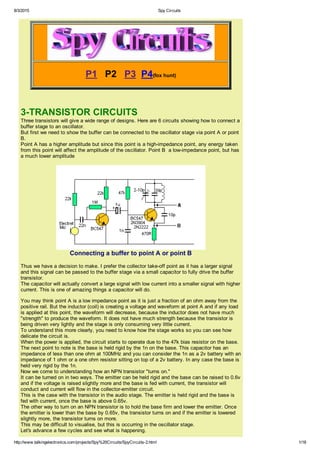
Spy circuits p2
- 11. 8/3/2015 Spy Circuits http://www.talkingelectronics.com/projects/Spy%20Circuits/SpyCircuits2.html 11/18 Transistors in parallel does not produce a higher output HOW A CAPACITOR WORKS It's handy to know the effective reactance (resistance) of a capacitor at the operating frequency of the circuit. If we assume 100MHz, the resistance is as follows: Capacitance reactance @100MHz reactance @2kHz 5.6p 300R 10p 166R 22p 75R 47p 35R 1n 1R6 22n much less than 1R 3k7 1u 82R How a capacitor works depends on where it is placed. A 22n across the power rails will be like a small battery equal to the voltage of the supply, but with an internal resistance of less than one ohm. When a battery has a low internal impedance, a high current can be taken without the voltage dropping. You may not think the oscillator circuit takes a high current but if the average is 10mA, there will be times when the circuit requires 20mA, and times when it needs 1mA. If the voltage dips when the circuit is trying to charge a capacitor, for example, the capacitor will not get charged to its maximum. This is what happens with the circuits above. As soon as you put a 22n across the battery, the output increase a small amount. Not only does the output increase, but the increase stays throughout the life of the battery, especially when it is getting flat. So the 22n across the battery is very important. A ceramic capacitor is able to supply this tiny amount of charge very quickly and this is needed as the circuit is working at 100,000,000 times per second. An electrolytic is not able to supply a tiny amount of charge at this fast rate and so an electrolytic is not suitable for the supply "decoupler." A decoupler is the name given to any capacitor that is placed across the supply rails to suppress spikes or prevent the effects of one stage from interfering with another stage. It "decouples" or "separates." When a capacitor is used to "couple" one stage to the next, such as the 22n between the microphone and base of the audio amplifier, the capacitor has a certain resistance at the frequency of the signal and since this is audio, it has an effective resistance of about 4k. If you put a 4k resistor in place of the 22n, you can see any signal produced by the microphone is only a few kilo ohms away from the base of the audio transistor. The audio transistor has an input impedance of about 4k and thus the two resistances can be seen as joined together in series with the input of the transistor at their middle. They form a voltage divider in which 50% of the signal produced by the microphone is delivered to the transistor. This is a very simple way to see the situation, so that if the 22n is replaced by a 1n, very little of the signal produced by the microphone will be delivered to the transistor. But if the 22n is replaced by a 1u, abut 95% of the signal will be delivered. That's a choice you have to make. Experiment with the two values and see if the improvement is noticeable. When a capacitor is used to stabilize a voltage in a building block, such as the 1n on the base of the